The Science Behind Toffee's Signature Flavor
Understanding what does toffee taste like requires examining the chemical transformations during its preparation. When sugar and butter cook together at precisely 300°F (149°C), the Maillard reaction and caramelization create toffee's distinctive flavor profile. Food scientists at the Institute of Food Technologists confirm that this specific temperature range produces over 60 flavor compounds that contribute to toffee's complexity—far more than simpler caramel candies.
Professional pastry chefs note that the quality of butter significantly impacts final taste. European-style butter with higher fat content (82-86%) creates a richer, more nuanced flavor compared to standard American butter (80% fat). The slow cooking process allows milk solids in butter to toast gradually, developing those characteristic nutty notes that define authentic toffee taste.

Texture's Crucial Role in Flavor Perception
What does English toffee taste like versus American varieties? The answer lies partly in texture. Traditional English toffee features a thinner, crispier snap that delivers an immediate flavor burst, while American versions often incorporate almonds for contrasting texture. Sensory researchers at Kansas State University's Food Science Institute found that texture directly influences flavor release—harder candies like toffee release flavors more gradually as they melt, creating an evolving taste experience.
When you bite into quality toffee, you'll experience:
- An initial crisp shatter that releases volatile aroma compounds
- A gradual buttery richness as the candy warms in your mouth
- Development of deeper, almost coffee-like roasted notes
- A clean finish without lingering stickiness
How Toffee Differs From Similar Confections
Many confuse toffee with caramel or butterscotch, but understanding what toffee tastes like requires distinguishing these similar treats. The key differences lie in ingredients, cooking temperature, and resulting flavor complexity:
| Confection | Primary Ingredients | Cooking Temp | Flavor Profile |
|---|---|---|---|
| Toffee | Sugar, butter, often nuts | 300°F (hard crack) | Rich buttery, complex roasted notes, subtle bitterness |
| Caramel | Sugar, cream, butter | 245°F (firm ball) | Sweet, creamy, one-dimensional sugar focus |
| Butterscotch | Brown sugar, butter | 285°F (soft crack) | Molasses-forward, less complex, sweeter finish |
This comparison explains why many describe toffee as "caramel's sophisticated older sibling"—it achieves greater flavor complexity through higher cooking temperatures and precise ingredient ratios.
Historical Evolution of Toffee Flavor
Toffee's distinctive taste has evolved significantly since its 19th century origins. Historical food records from the British Library show early toffees relied on treacle (a byproduct of sugar refining) which created a darker, more bitter profile. The modern buttery toffee taste emerged in the early 20th century when manufacturers standardized butter-to-sugar ratios.
1840s: First documented toffee recipes in England using treacle and molasses
1880s: Butter becomes primary fat source, creating smoother texture
1920s: Almond addition popularized in American toffee
1950s: Chocolate coating becomes standard finishing touch
2000s: Artisanal toffees experiment with sea salt, espresso, and premium ingredients
Contextual Factors That Alter Toffee Taste
Several variables affect what toffee tastes like in different situations:
- Temperature effects: Cold toffee (straight from refrigerator) delivers sharper sweetness with less buttery aroma, while room-temperature toffee offers more balanced flavor release
- Accompaniments matter: As noted in America's Test Kitchen research, pairing toffee with strong coffee or aged cheeses creates flavor contrasts that highlight different aspects of its taste profile
- Freshness window: Toffee maintains optimal flavor for 2-3 weeks when properly stored—beyond this, moisture absorption dulls the crisp texture essential to its characteristic taste experience
Common Misconceptions About Toffee Flavor
Several myths persist about what toffee tastes like:
- "Toffee is just hard caramel" - Incorrect. The higher cooking temperature creates different chemical compounds through advanced Maillard reactions
- "All toffee tastes the same" - Quality varies dramatically based on ingredient ratios and cooking precision
- "The bitterness means it's burned" - That subtle bitter note is intentional and essential to balance the intense sweetness
Perfect Pairings to Enhance Toffee's Flavor
Understanding what toffee tastes like helps identify ideal pairings. Food pairing experts at the Culinary Institute of America recommend:
- Coffee: Medium-roast Colombian coffee complements toffee's nutty notes
- Tea: English breakfast tea cuts through the richness
- Wine: Tawny port creates a harmonious flavor bridge
- Cheese: Aged cheddar provides salty contrast that heightens toffee's sweetness
These combinations don't mask toffee's distinctive flavor but rather highlight different dimensions of what makes this confection so special.











 浙公网安备
33010002000092号
浙公网安备
33010002000092号 浙B2-20120091-4
浙B2-20120091-4